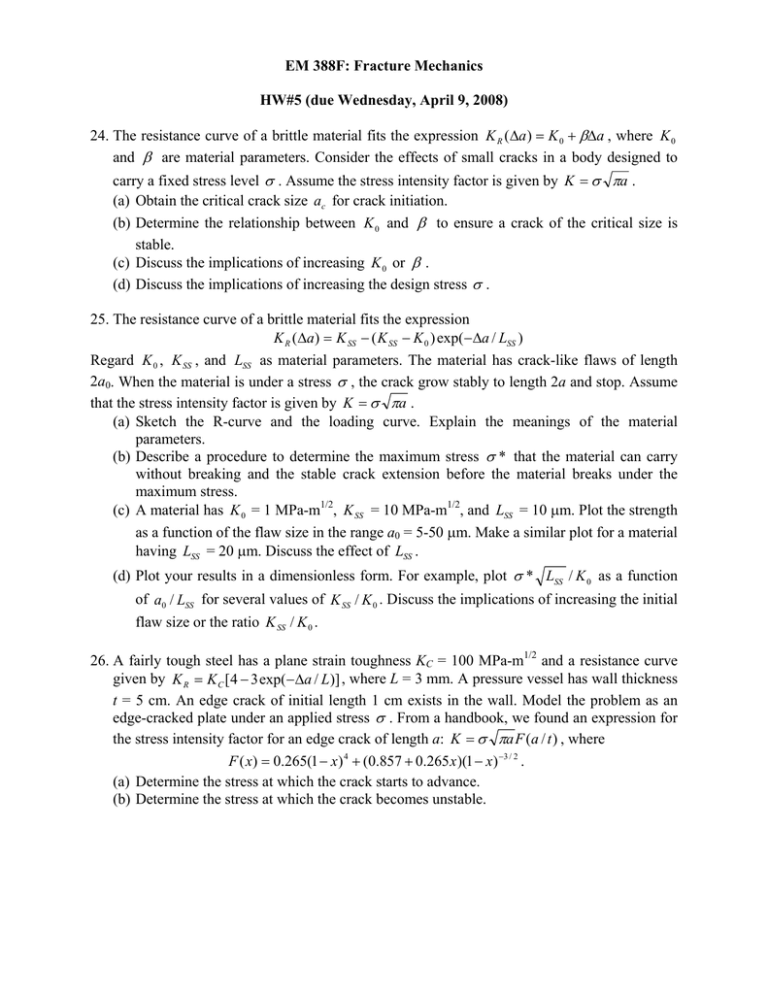β
advertisement

EM 388F: Fracture Mechanics HW#5 (due Wednesday, April 9, 2008) 24. The resistance curve of a brittle material fits the expression K R (Δa ) = K 0 + βΔa , where K 0 and β are material parameters. Consider the effects of small cracks in a body designed to carry a fixed stress level σ . Assume the stress intensity factor is given by K = σ πa . (a) Obtain the critical crack size ac for crack initiation. (b) Determine the relationship between K 0 and β to ensure a crack of the critical size is stable. (c) Discuss the implications of increasing K 0 or β . (d) Discuss the implications of increasing the design stress σ . 25. The resistance curve of a brittle material fits the expression K R (Δa) = K SS − ( K SS − K 0 ) exp(− Δa / LSS ) Regard K 0 , K SS , and LSS as material parameters. The material has crack-like flaws of length 2a0. When the material is under a stress σ , the crack grow stably to length 2a and stop. Assume that the stress intensity factor is given by K = σ πa . (a) Sketch the R-curve and the loading curve. Explain the meanings of the material parameters. (b) Describe a procedure to determine the maximum stress σ * that the material can carry without breaking and the stable crack extension before the material breaks under the maximum stress. (c) A material has K 0 = 1 MPa-m1/2, K SS = 10 MPa-m1/2, and LSS = 10 μm. Plot the strength as a function of the flaw size in the range a0 = 5-50 μm. Make a similar plot for a material having LSS = 20 μm. Discuss the effect of LSS . (d) Plot your results in a dimensionless form. For example, plot σ * LSS / K 0 as a function of a0 / LSS for several values of K SS / K 0 . Discuss the implications of increasing the initial flaw size or the ratio K SS / K 0 . 26. A fairly tough steel has a plane strain toughness KC = 100 MPa-m1/2 and a resistance curve given by K R = K C [4 − 3 exp(− Δa / L)] , where L = 3 mm. A pressure vessel has wall thickness t = 5 cm. An edge crack of initial length 1 cm exists in the wall. Model the problem as an edge-cracked plate under an applied stress σ . From a handbook, we found an expression for the stress intensity factor for an edge crack of length a: K = σ πa F (a / t ) , where F ( x) = 0.265(1 − x) 4 + (0.857 + 0.265 x)(1 − x) −3 / 2 . (a) Determine the stress at which the crack starts to advance. (b) Determine the stress at which the crack becomes unstable. 27. An aluminum has a fracture toughness Kc = 30 MPa-m1/2. Under a cyclic load, a crack in the 4 ⎛ ΔK ⎞ da ⎟⎟ , where β = 1 μm/cycle. A large plate of the aluminum extends per cycle by = β ⎜⎜ dN ⎝ Kc ⎠ aluminum is subjected to a cyclic tensile stress varying between 0 and 200 MPa. A surface crack has initial depth a0 = 500 μm. (a) How many cycles does it take for the crack to double its depth? (b) How many cycles does it take for the aluminum plate to undergo fast fracture? (c) The threshold stress intensity factor has been estimated to be Kth = 3 MPa-m1/2. Determine the critical stress range, below which the crack will not grow. 28. An aluminum alloy for an airframe component was tested in the laboratory under an applied stress that varies sinusoidally with time about a mean stress of zero. The alloy failed under a stress amplitude of 140 MPa after 105 cycles and under a stress amplitude of 100 MPa after 107 cycles. Assume that the number of cycles to failure, Nf, relates to the stress amplitude by an empirical formula (Basquin’s law): σ a N mf = C . (a) Use the test results to determine the constants m and C. (b) An aircraft using the airframe component has encountered an estimated 4 × 108 cycles at a stress amplitude of 75 MPa. It is desired to extend the airframe life by another 4 × 108 cycles by reducing the stress amplitude. Find the reduction in stress amplitude necessary to achieve the desired lifetime.





